

(this is Chapter 18 of Adventures in Physics, available only online)
Ch 18, Image Formation: Mirrors and Lenses; 1, 2, 3, 4, 5, 6, 7, 9, 11, 12, 17, 19, 20, 25, 26
Calculational 5
![]()
1. With your eye positioned relative to a plane mirror as shown in the figure, which of the circles will you see, a, b, or c?

2. Why do some ambulance companies write ![]() on the front of their vehicles "backward"? Why would they not write it that
way on the side or back of the vehicle?
on the front of their vehicles "backward"? Why would they not write it that
way on the side or back of the vehicle?
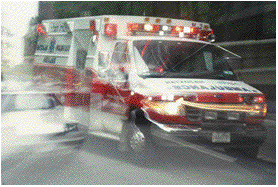

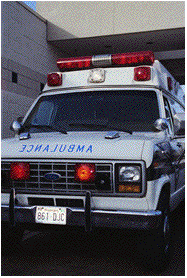
The wordon the front of an ambulance will likely be seen in a rear view mirror where it will be reverse right-for-left and then will be easily read. Anything written on the back of the ambulance will not likely be seen in a mirror.
3. What is the minimum length of a mirror you need to see your entire height -- from the top of your head to the bottom of your toes? Does it make any difference how far you are from the mirror? Diagrams will help.

When you stand in front of a mirror you see your image behind the mirror with an image distance equal to the object distance. That is, your image is behind the mirror exactly the same distance as you are standing in front of the mirror. AB is a ray of light that seems to come from the head of your image to your eye. CB is a ray of light that seems to come from the foot of your image to your eye. Triangle ABC is similar to triangle DBE. Length BD is just one-half of distance BA so length DE is just one-half of distance AC. Length DE is the minimum length of a mirror you need. Length AC is the height of your image -- and, of course, that is just your length.
4. How many images are produced in the corner where two plane mirrors come together perpendicular to each other?
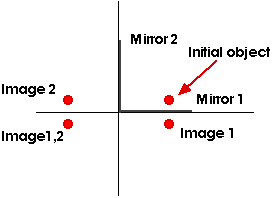
Three images are formed. Two images -- labeled "Image 1" and "Image 2" in the diagram -- are formed by a reflection from a single mirror. The third image -- labeled "Image 1, 2" in the diagram -- is formed by light that is reflected from both mirrors.
5. How many images are produced in a 3D corner where three plane mirrors come together, mutually perpendicular to each other?
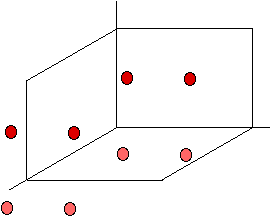
In question 4, we have already seen that two mirrors at 90o will produce three images. These three images (plus the initial object) are shown in dark red. Placing the third mirror here, to make a 3D corner, provides an image of each of these for a total of seven images (plus the initial object).
6. How many images will be produced by two plane mirrors that are placed together at 45°?
Let's take these reflections a step at a time, . . .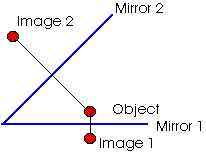
Including the initial object, there will be eight things to see -- seven images plus the original.
7. Use a diagram to show that if a beam of light is reflected from a mirror and the mirror is moved through some angle, the reflected beam will be moved through twice that angle. This is employed in an "optical lever" arrangement that is sometimes used in physics experiments to measure very small angular displacements.
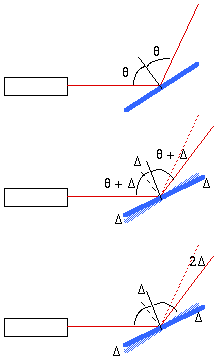
9. Carefully draw a ray diagram for an object placed 50 cm from a concave mirror that has a focal length of 15 cm. Describe the image that is formed.
Ray diagrams are important (and will surely reappear on the next exam and the final). Ray diagrams are also easy -- and even fun, I hope!
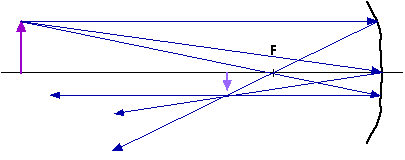
This image is real - meaning the light actually passes through the image.
This image is inverted.
This image is smaller.
From my measurement on this diagram, the image distance is about 22 cm.
11. Use a carefully drawn ray diagram to describe the image produced by a concave mirror with focal length of f = 20 cm when an object is 15 cm away from the mirror.
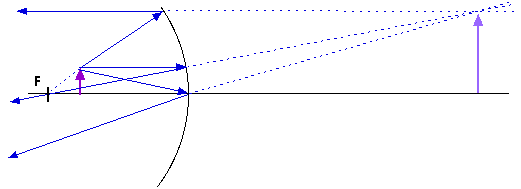
This image is virtual; the light does not pass through the image.
This image is upright.
This image is enlarged.
From my measurement of the distances, this image is located about 40 cm behind the mirror.
12. Carefully draw a ray diagram to locate and describe the image produced by a concave mirror whose focal length is 10 cm when an object is placed 30 cm away. Is the image real or virtual? Is it right side up or upside down? Is it larger or smaller than the object?
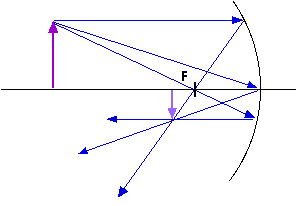
This image is real; the light actually passes through the image.
This image is upside down.
This image is smaller than the object.
By my measurement of the distances in the diagram, the image is located about 14 cm from the mirror.
17. Why might a store place a convex mirror someplace where it can be seen by a check-out clerk?
The convex mirror produces images that are smaller so an image of the entire store (or most of it, at least) can be seen in the convex mirror.
19. Where, in relation to the focal point, should an object be placed, in front of a converging lens, to produce a real image? Where should it be placed to produce a virtual image?
A real image is produce if the object is farther away from the lens than the focal point.A virtual image is produce if the object is between the lens and the focal point.
20. Carefully draw a ray diagram for an object placed 50 cm from a converging lens that has a focal length of 15 cm. Describe the image that is formed. Is the image real or virtual? Is it right side up or inverted? Is it enlarged or reduced?
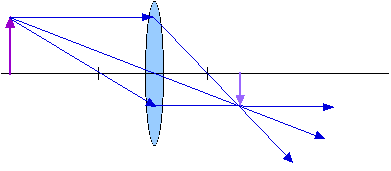
This image is real; the light actually passes through the image.
This image is upside down.
This image is smaller than the object.
By my measurement of the distances in the diagram, the image is located about 28 cm from the lens.
25. Carefully draw a ray diagram to locate and characterize the image produced by a diverging lens with a focal length of - 20 cm when an object is located 40 cm away from the lens. Is the image real or virtual? Is it right side up or upside down? Is it larger or smaller than the object?

This image is virtual; the light does not pass through the image.
This image is upright
This image is smaller than the object.
From my measurement of the diagram, the image appears to be located about 15 cm from the lens.
26. Carefully draw a ray diagram to locate and describe the image produced by a diverging lens with a focal length of - 30 cm when an object is located 15 cm away from the lens. Is the image real or virtual? Is it right side up or inverted? Is it larger or smaller than the object?
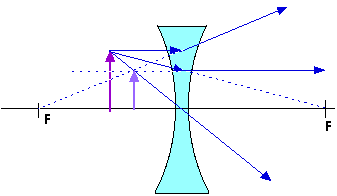
This image is virtual; the light does not pass through the image.
This image is upright.
This image is smaller than the object.
From my measurement of the diagram, the image appears to be located about 10 cm from the lens.
![]() Calculational
Questions
Calculational
Questions
5. What is the real depth or position of a fish that appears to be 10 cm from the wall of a fresh-water aquarium?
The real depth do and the apparent depth di are related bydi = do / n This means
do = n di For water, n = 1.33, so
do = (1.33) (10 cm) do = 13.3 cm
![]()
Typical multiple-guess questions over this material:
1. Refraction causes the bottom of a swimming pool to appear
a) farther away than it really isb) closer to the surface than it really is
2. Your image in a plane mirror is
a) virtualb) real
c) both of these
3. The type of lens that spreads parallel light is a
a) converging lensb) diverging lens
c) either of these
4. Which of the following can be projected onto a viewing screen?
a) a virtual imageb) a real image
c) a convex image
d) a concave image
5. The image of something "infinitely far away", like the Sun, produced by a converging lens appears
a) between the lens and the focal pointb) at the focal point
c) between the focal point and twice the focal length
d) at twice the focal length
6. Your vision is sharpest when your pupil is
a) dilated or opened wideb) constricted or made tiny
c) blue
d) brown
7. A 2-m tall person viewing his full-length image in a plane mirror requires a mirror that is at least
a) 0.5 mb) 1.0 m.
c) 2.0 m.
d) This depends upon how far the person is from the mirror.
8. An object is placed 20 cm from a converging lens that has a focal length of 10 cm. Make a ray diagram of this situation. From the ray diagram, characterize the image.
The image is
a) real and inverted (and the same size)b) virtual, inverted, and smaller.
c) virtual, upright, and smaller.
d) virtual, inverted, and larger.
9. An object is placed 30 cm from a converging lens that has a focal length of 10 cm. Make a ray diagram of this situation. From the ray diagram, characterize the image.
The image is
a) real, inverted, and larger.b) real, inverted, and smaller.
c) virtual, upright, and smaller.
d) virtual, inverted, and smaller.
10. An object is placed 15 cm from a converging lens that has a focal length of 10 cm. Make a ray diagram of this situation. From the ray diagram, characterize the image.
The image is
a) real, inverted, and larger.b) real, inverted, and smaller.
c) real, upright, and smaller.
d) virtual, upright, and larger.
11. An object is placed 5 cm from a converging lens that has a focal length of 10 cm. Make a ray diagram of this situation. From the ray diagram, characterize the image.
The image is
a) real, inverted, and larger.b) real, inverted, and smaller.
c) virtual, upright, and smaller.
d) virtual, upright, and larger.
Answers to typical multiple-guess questions over this material:
1. Refraction causes the bottom of a swimming pool to appear
a) farther away than it really isb) closer to the surface than it really is
2. Your image in a plane mirror is
a) virtualb) real
c) both of these
3. The type of lens that spreads parallel light is a
a) converging lens |
|
4. Which of the following can be projected onto a viewing screen?
a) a virtual imageb) a real image
c) a convex image
d) a concave image
5. The image of something "infinitely far away", like the Sun, produced by a converging lens appears
a) between the lens and the focal pointb) at the focal point
c) between the focal point and twice the focal length
d) at twice the focal length
6. Your vision is sharpest when your pupil is
a) dilated or opened wideb) constricted or made tiny
c) blue
d) brown
7. A 2-m tall person viewing his full-length image in a plane mirror requires a mirror that is at least
a) 0.5 m |
|
8. An object is placed 20 cm from a converging lens that has a focal length of 10 cm. Make a ray diagram of this situation. From the ray diagram, characterize the image.

The image is
a) real and inverted (and the same size)b) virtual, inverted, and smaller.
c) virtual, upright, and smaller.
d) virtual, inverted, and larger.
9. An object is placed 30 cm from a converging lens that has a focal length of 10 cm. Make a ray diagram of this situation. From the ray diagram, characterize the image.

The image is
a) real, inverted, and larger.b) real, inverted, and smaller.
c) virtual, upright, and smaller.
d) virtual, inverted, and smaller.
10. An object is placed 15 cm from a converging lens that has a focal length of 10 cm. Make a ray diagram of this situation. From the ray diagram, characterize the image.
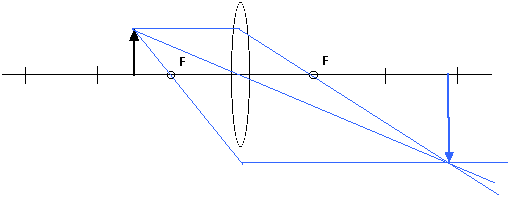
The image is
a) real, inverted, and larger.b) real, inverted, and smaller.
c) real, upright, and smaller.
d) virtual, upright, and larger.
11. An object is placed 5 cm from a converging lens that has a focal length of 10 cm. Make a ray diagram of this situation. From the ray diagram, characterize the image.
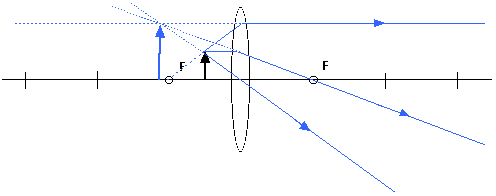
The image is
a) real, inverted, and larger.b) real, inverted, and smaller.
c) virtual, upright, and smaller.
d) virtual, upright, and larger.